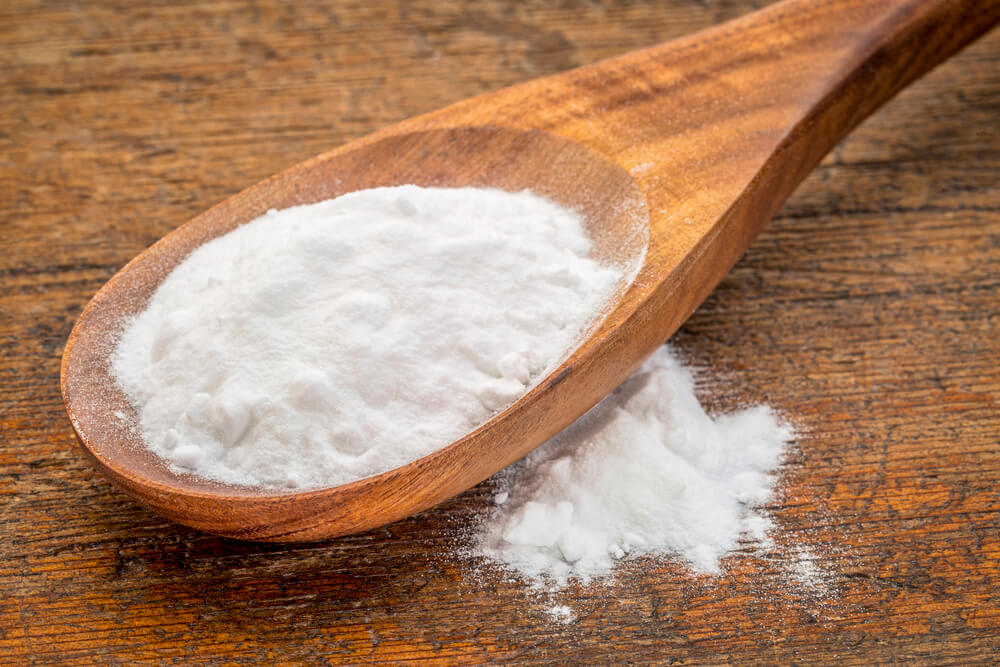Table of Contents:
Can I Put Baking Soda on Bee Stings?
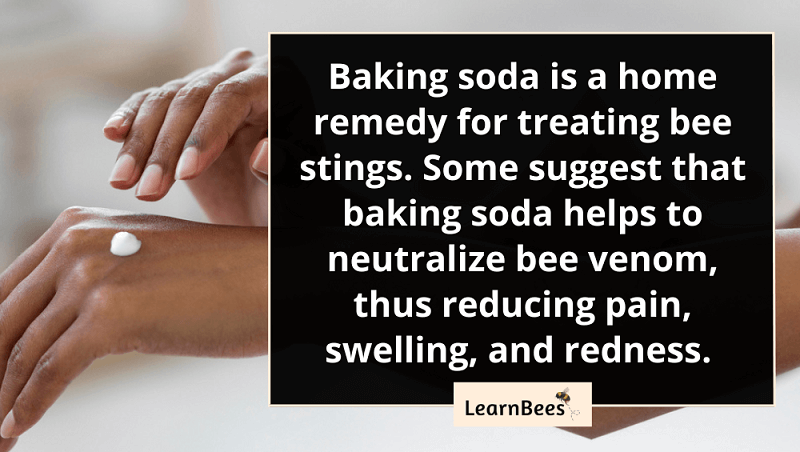
Baking soda can be used to treat bee stings and insect bites.
That said, calamine lotion is one of the most recommended bee sting treatments.
Calamine lotion is antibacterial and anti-inflammatory, so it’s good to have it in the medicine cabinet. It relieves the itching, pain, and redness associated with bee stings, bug bites, poison ivy, poison oak, swimmer’s itch, and even chicken pox.
However, many people turn to baking soda because it’s an inexpensive and common household item.
While more research is needed to confirm baking soda’s healing properties, anecdotal evidence suggests it can reduce itching, swelling, and redness.
Some suggest that baking soda can neutralize the venom from bee stings. But again, more research is needed to back up that claim.
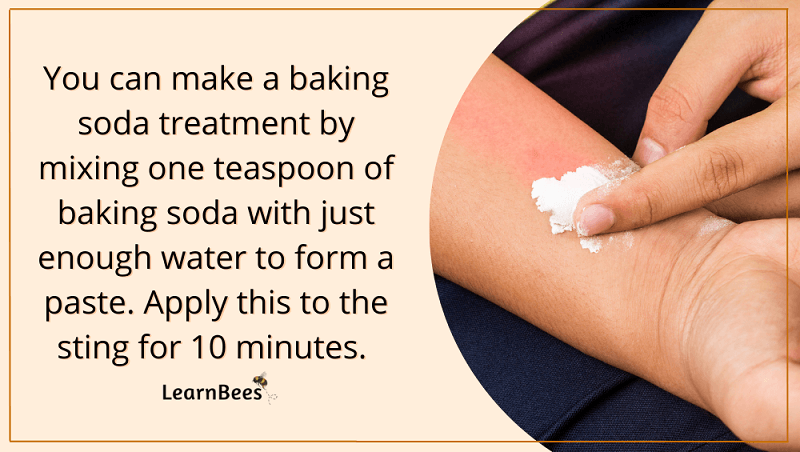
With that in mind, the Centers for Disease Control and Prevention (CDC) offer the following recipe to calm insect bites:(1)
- Mix just enough water with a teaspoon of baking soda to form a thick paste
- Apply the baking soda to the affected area
- Allow it to sit for 10 minutes before rinsing it off
The baking soda paste can also be left on the bee sting overnight. Cover it with a bandage to avoid transferring baking soda to bedsheets.
Just remember:
Remove the bee’s stinger first (if applicable), then cleanse the area with soap and warm water. Cleaning the sting site reduces the chances of infection.
You can also soak in a baking soda bath if you’ve experienced multiple bee stings or bee stings in hard-to-reach areas. Start by dissolving two to three cups of baking soda in warm water. Next, soak in the solution for at least 20 minutes before washing well with soap and water.
Keep in mind:
Baking soda can be drying to the skin, so you may need to use a gentle moisturizer after.
Visit a doctor if you experience irregular side effects, pain, or rashes.
Does Baking Soda Help Draw out the Bee’s Stinger?
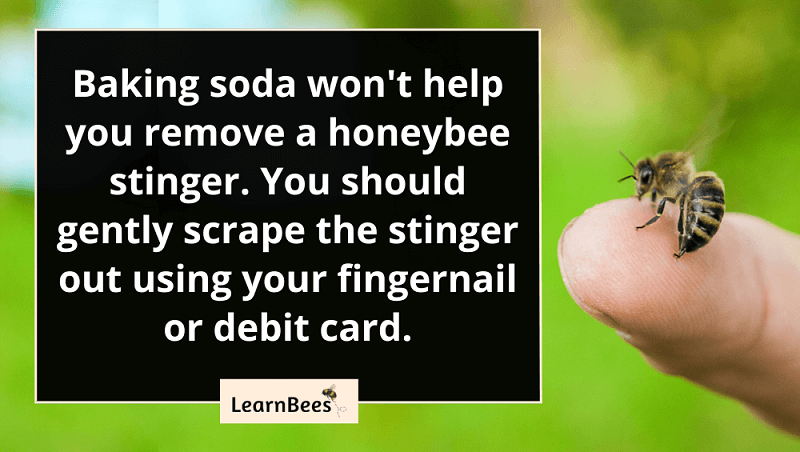
Baking soda won’t help draw out a bee’s stinger.
The best way to remove a honeybee stinger is to gently scrape it out with a blunt object like a debit card or driver’s license. You can also use your fingernail to tug the stinger out of the skin.
Bee stingers look like tiny black dots on the skin. They’re typically attached to a venom sac, which releases a small amount of venom into the skin.
But here’s the thing:
Not all bees leave their stingers behind.
In fact, honeybees are the only species of bee that lose their stingers after stinging. This means you won’t have to worry about removing a stinger if you were stung by a bumblebee, carpenter bee, or another type of bee.
The same is true for wasps.
Unlike honeybees, wasps don’t lose their stingers. Yellowjacket wasps are commonly mistaken for honeybees because they have similar coloring and size. They also live in social colonies like honeybees.
That said, you won’t have to remove a stinger if you were stung by a yellowjacket.
What Should I Do if Baking Soda Doesn’t Help?
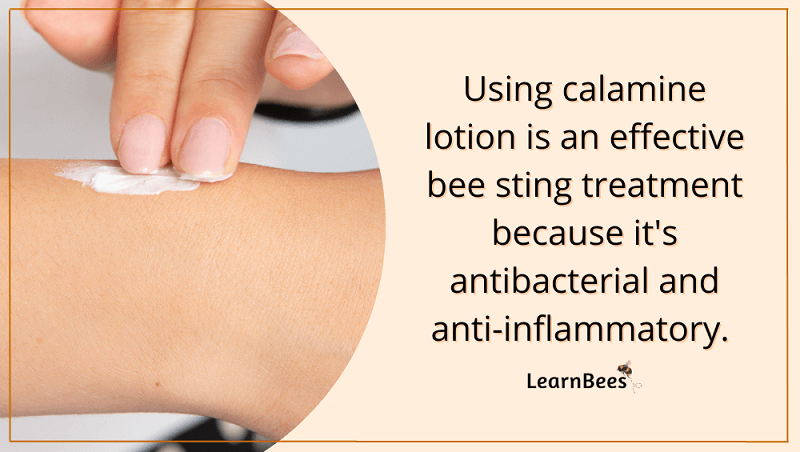
Most bee stings cause mild reactions. There may be slight swelling and redness that persist for a few hours after the sting, followed by itching that lasts for a few days.
If putting baking soda on the bee sting doesn’t help, then you can try these other treatment options:
- Calamine lotion to reduce irritation and itching
- Ice to reduce swelling and pain
- Antihistamines such as Benadryl to provide quick relief
- Anti-inflammatory medications such as Motrin or Advil to reduce inflammation
- Hydrocortisone cream to treat itching and redness
Fortunately, most individuals deal with bee sting symptoms for less than 24 hours. The likelihood of a severe reaction is rare as long as the sting site is cleansed correctly with soap and water.
If you experience any of the following after a bee sting, then you should seek immediate medical attention:
- Hives or welts that spread beyond the initial sting site
- Swelling of the face, lips, or throat
- Difficulty breathing or swallowing
- Dizziness or lightheadedness
- Fainting
FAQs for Baking Soda on Bee Stings
- How long should I leave baking soda on the bee sting?
- How often should I apply baking soda to the bee sting?
- Does baking soda on a bee sting reduce swelling?
- Does baking soda on a bee sting reduce itching?
- Does baking soda on a bee sting reduce redness?
- How do you mix baking soda for bee stings?
- What are the side effects of using baking soda for bee stings?
- What can you put on a bee sting to take out the sting?
- Why should baking soda be rubbed on the bee sting area?
- Why does baking soda not relieve bee stings?
- How long should I leave baking soda on a bee sting?
- Does baking soda help remove the bee’s stinger?
- Does baking soda make bee stings worse?
How long should I leave baking soda on the bee sting?
You should allow the baking soda paste to sit on the sting site for at least 10 minutes before rinsing. This gives the paste a chance to enter the skin and cleanse the area.
However, you can leave the baking soda on for longer, and sometimes overnight, as long as you don’t experience irritation or dryness. Baking soda will harden and crust off if left for multiple hours. You can deal with this by laying a clean bandage over the area so the baking soda doesn’t crumble away.
A bandage will also prevent the baking soda paste from transferring to your clothes, bed sheets, or other body parts.
In addition, some people take baking soda baths to treat bee stings or insect bites. This treatment option can heal bee stings in hard-to-reach locations such as your lower or upper back.
To take a baking soda bath, dissolve two to three cups of baking soda in warm water. Stir the water to ensure the baking soda is distributed correctly.
Next, soak in the bath for at least 20 minutes to allow the baking soda to penetrate the bee stings. Finally, clean your skin with water and a gentle, fragrance-free soap bar. Fragrances or essential oils can irritate open wounds and bee stings, so be cautious.
If your skin feels dry after the baking soda treatment, then apply a moisturizer to the area.
—> Go back to the FAQs for baking soda on bee stings
More to Explore:
- How to Remove a Bee Stinger Stuck Under Skin
- 15 Fun Facts About Bees
- 8 Popular Flowers for a Bee Garden
How often should I apply baking soda to the bee sting?
You can apply baking soda to bee stings twice daily, as needed.
But in most cases, bee sting reactions subside within 24 hours. You’ll experience redness and slight swelling within the first few hours, but those will gradually disappear.
It’s normal for itching to linger for several days after the sting occurs. You can treat the itching using calamine lotion, hydrocortisone cream, or an antihistamine.
If you see no improvement in your symptoms after 72 hours or your reaction worsens, consult a medical professional.
—> Go back to the FAQs for baking soda on bee stings
More to Explore:
Does baking soda on a bee sting reduce swelling?
There is anecdotal evidence suggesting that baking soda can help reduce swelling from bee stings. However, there is no scientific evidence to support this claim.
Many people use baking soda as a home remedy to soothe bee stings, bug bites, and other skin issues. Baking soda is affordable and easy to find. So, if you’re looking for a natural way to reduce swelling, then baking soda may be worth trying.
Swelling should also reduce naturally over several hours or a few days. It’s not uncommon for swelling to last 4-6 hours, then gradually improve.
If your bee sting symptoms worsen, or you experience severe reactions such as throat swelling and hives, then please consult a doctor immediately.
—> Go back to the FAQs for baking soda on bee stings
More to Explore:
Does baking soda on a bee sting reduce itching?
There is anecdotal evidence suggesting that baking soda can reduce itching caused by bee stings. However, there is no scientific evidence to prove this claim.
The baking soda paste may help to numb the itch sensation. Baking soda also has anti-inflammatory properties, which may help to soothe the skin and reduce itching.
Baking soda is inexpensive and easily found at grocery stores. That makes it popular as an add-on treatment for a wide range of stings and bug bites.
—> Go back to the FAQs for baking soda on bee stings
More to Explore:
Does baking soda on a bee sting reduce redness?
Baking soda is believed to have anti-inflammatory properties that decrease redness, swelling, and soreness. This is why some people apply baking soda to bee stings as a home remedy treatment.
However, no scientific evidence proves that baking soda can help reduce redness caused by bee stings.
But if you’re looking for a natural way to reduce redness and swelling, then baking soda is a safe treatment option for most.
—> Go back to the FAQs for baking soda on bee stings
More to Explore:
How do you mix baking soda for bee stings?
Making your baking soda paste is easy. Simply mix one teaspoon of baking soda with just enough water to form a thick paste.
You can then apply the paste directly to the bee sting. Allow the paste to rest on the skin for at least 10 minutes, then rinse it with warm water.
You can also add two to three cups of baking soda to your bathwater and soak in it for 20 minutes.
—> Go back to the FAQs for baking soda on bee stings
More to Explore:
What are the side effects of using baking soda for bee stings?
Baking soda is a safe and affordable treatment option for bee stings and insect bites. However, there are a few potential side effects to be aware of.
If you have sensitive skin, then you may experience mild irritation from the baking soda paste. Baking soda can be drying if left on the skin for too long, so be sure to rinse it off after 10-15 minutes if you’re prone to dryness.
It’s also important not to use baking soda too frequently, which can lead to skin irritation. If you find that your skin is getting red or inflamed from using baking soda, then discontinue use and consult with a doctor.
—> Go back to the FAQs for baking soda on bee stings
More to Explore:
What can you put on a bee sting to take out the sting?
The best way to remove a honeybee stinger is to scrape it out with your fingernail or a debit card. This helps to prevent more venom from being injected into your skin.
If you cannot remove the stinger, then tweezers can also be used. However, try to avoid squeezing the venom sac attached to the stinger, as this can cause more venom to be released.
—> Go back to the FAQs for baking soda on bee stings
More to Explore:
- Ground Bees: Are They a Threat to Your Yard?
- Wasps vs. Honeybees: Are They Different?
- Do Bumble Bees Bite?
Why should baking soda be rubbed on the bee sting area?
Baking soda can be rubbed on the bee sting area because it’s believed to be a safe and effective way to reduce swelling and redness.
Additionally, baking soda can reduce itching, lasting for several hours or days. But remember, baking soda will not remove the bee’s stinger. You must gently pull the stinger out yourself if you were stung by a honeybee.
—> Go back to the FAQs for baking soda on bee stings
More to Explore:
Why does baking soda not relieve bee stings?
Baking soda is not an end-all-be-all treatment for bee stings. It may be effective for some, but others may have to try other treatment options, such as calamine lotion, hydrocortisone cream, or ice.
—> Go back to the FAQs for baking soda on bee stings
More to Explore:
- Do Carpenter Bees Pollinate?
- How Long Do Bumble Bees Live?
- Honeybees vs. Bumblebees: How Do They Compare?
How long should I leave baking soda on a bee sting?
You should leave baking soda on a bee sting for at least 10 minutes or until the paste dries. If you have sensitive skin, keep an eye on the area to ensure your skin doesn’t dry out from the paste.
—> Go back to the FAQs for baking soda on bee stings
More to Explore:
- Do Queen Bees Eat Honey?
- Are Worker Bees Male or Female?
- Queen Bee Versus Worker Bees – How Do They Compare?
Does baking soda help remove the bee’s stinger?
People often ask, “Does baking soda draw out the bee’s stinger?”
The answer is no. The only way to remove the bee’s stinger is to softly scrape the stinger away using your fingernail or a hard object like a debit card.
Sometimes the bee stinger will work itself out on its own, but it’s best to remove it so you can cleanse the area and reduce the amount of venom injected into the skin.
—> Go back to the FAQs for baking soda on bee stings
More to Explore:
Does baking soda make bee stings worse?
Baking soda shouldn’t make bee stings worse. Instead, it should help heal them. But if you experience worsening symptoms, then stop using the baking soda paste and seek medical attention.
